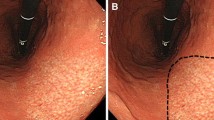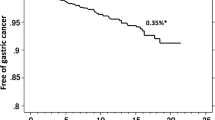Abstract
The natural course of Helicobacter pylori (H. pylori) is poorly understood, as most research in the field has been on patient populations. We studied the natural course of H. pylori and its associations to morphological changes of the gastric mucosa, peptic ulcer, and reflux oesophagitis in a prospective cohort study of subjects with and without dyspepsia. A total of 361 adults (201 men/160 women, mean age 41/42 years) in Sørreisa municipality, Norway who in 1987 were subjected to upper endoscopy and assessed for gastrointestinal symptoms and H. pylori status were followed up in 2004. H. pylori was strongly associated with neutrophilic (odds ratio [OR] 23.79; 95% confidence interval [CI] 11.64:48.61) and mononuclear infiltration (OR 9.43; CI 5.12:17.36), moderately with atrophy of the antrum (OR 1.98; CI 1.17:3.34), but not with atrophy of the gastric body or intestinal metaplasia. Elimination of H. pylori was associated with regression of gastric inflammation and atrophy, whereas intestinal metaplasia progressed. H. pylori was positively associated with peptic ulcer (OR 2.69; CI 1.2:6.02) but not significantly negatively associated with oesophagitis (OR 0.62; CI 0.35:1.09). This is the first prospective study including endoscopic findings of subjects without dyspepsia, to show that the impact of H. pylori on gastric atrophy is only modest, and that eliminating H. pylori does not cause regression of intestinal metaplasia. However, inflammation of the gastric mucosa regresses after H. pylori elimination. H. pylori is only a moderate risk factor for peptic ulcer, and other explanatory factors deserve more attention.

Similar content being viewed by others
Abbreviations
- ASA:
-
Acetylsalicylic acid
- CI:
-
Confidence interval
- GORD:
-
Gastro-oesophageal reflux disease
- H. pylori :
-
Helicobacter pylori
- NSAIDs:
-
Non-steroid anti-inflammatory drugs
- OR:
-
Odds ratio
- PU:
-
Peptic ulcer
References
Marshall BJ, Warren JR. Unidentified curved bacilli in the stomach of patients with gastritis and peptic ulceration. Lancet. 1984;1:1311–5.
Axon AT. Relationship between Helicobacter pylori gastritis, gastric cancer and gastric acid secretion. Adv Med Sci. 2007;52:55–60.
Talley NJ, Fock KM, Moayyedi P. Gastric Cancer Consensus conference recommends Helicobacter pylori screening and treatment in asymptomatic persons from high-risk populations to prevent gastric cancer. Am J Gastroenterol. 2008;103:510–4.
Makola D, Peura DA, Crowe SE. Helicobacter pylori infection and related gastrointestinal diseases. J Clin Gastroenterol. 2007;41:548–58.
Papatheodoridis GV, Sougioultzis S, Archimandritis AJ. Effects of Helicobacter pylori and nonsteroidal anti-inflammatory drugs on peptic ulcer disease: a systematic review. Clin Gastroenterol Hepatol. 2006;4:130–42.
Talamini G, Tommasi M, Amadei V, et al. Risk factors of peptic ulcer in 4943 inpatients. J Clin Gastroenterol. 2008;42:373–80.
Xia HH, Phung N, Kalantar JS, et al. Demographic and endoscopic characteristics of patients with Helicobacter pylori positive and negative peptic ulcer disease. Med J Aust. 2000;173:515–9.
Ciociola AA, McSorley DJ, Turner K, et al. Helicobacter pylori infection rates in duodenal ulcer patients in the United States may be lower than previously estimated. Am J Gastroenterol. 1999;94:1834–40.
Bernersen B, Johnsen R, Straume B, et al. Towards a true prevalence of peptic ulcer: the Sorreisa gastrointestinal disorder study. Gut. 1990;31:989–92.
Bernersen B, Johnsen R, Straume B. Non-ulcer dyspepsia and peptic ulcer: the distribution in a population and their relation to risk factors. Gut. 1996;38:822–5.
Johnsen R, Bernersen B, Straume B, et al. Prevalences of endoscopic and histological findings in subjects with and without dyspepsia. BMJ. 1991;302:749–52.
Asfeldt AM, Lochen ML, Straume B, et al. Accuracy of a monoclonal antibody-based stool antigen test in the diagnosis of Helicobacter pylori infection. Scand J Gastroenterol. 2004;39:1073–7.
Lundell LR, Dent J, Bennett JR, et al. Endoscopic assessment of oesophagitis: clinical and functional correlates and further validation of the Los Angeles classification. Gut. 1999;45:172–80.
Rosenstock S, Jorgensen T, Bonnevie O, et al. Risk factors for peptic ulcer disease: a population based prospective cohort study comprising 2416 Danish adults. Gut. 2003;52:186–93.
Nordenstedt H, Nilsson M, Johnsen R, et al. Helicobacter pylori infection and gastroesophageal reflux in a population-based study (The HUNT Study). Helicobacter. 2007;12:16–22.
Asfeldt AM, Straume B, Paulssen EJ. Impact of observer variability on the usefulness of endoscopic images for the documentation of upper gastrointestinal endoscopy. Scand J Gastroenterol. 2007;42:1106–12.
Weck MN, Brenner H. Association of Helicobacter pylori infection with chronic atrophic gastritis: meta-analyses according to type of disease definition. Int J Cancer. 2008;123:874–81.
Koivisto TT, Voutilainen ME, Farkkila MA. Effect of smoking on gastric histology in Helicobacter pylori-positive gastritis. Scand J Gastroenterol. 2008;43:1177–83.
Nakamura M, Haruma K, Kamada T, et al. Cigarette smoking promotes atrophic gastritis in Helicobacter pylori-positive subjects. Dig Dis Sci. 2002;47:675–81.
Ricci C, Holton J, Vaira D. Diagnosis of Helicobacter pylori: invasive and non-invasive tests. Best Pract Res Clin Gastroenterol. 2007;21:299–313.
Rosenstock S, Jorgensen T, Andersen L, et al. Seroconversion and seroreversion in IgG antibodies to Helicobacter pylori: a serology based prospective cohort study. J Epidemiol Community Health. 2000;54:444–50.
Fawcett JP, Shaw JP, Brooke M, et al. Seroprevalence of Helicobacter pylori in a longitudinal study of New Zealanders at ages 11 and 21. Aust N Z J Med. 1998;28:585–9.
Lam SK. Epidemiology and genetics of peptic ulcer. Gastroenterol Jpn. 1993;28(Suppl 5):145–57.
Soncini M, Triossi O, Leo P, et al. Management of patients with nonvariceal upper gastrointestinal hemorrhage before and after the adoption of the Rockall score, in the Italian Gastroenterology Units. Eur J Gastroenterol Hepatol. 2007;19:543–7.
Hunt RH, Bazzoli F. Review article: should NSAID/low-dose aspirin takers be tested routinely for H. pylori infection and treated if positive? Implications for primary risk of ulcer and ulcer relapse after initial healing. Aliment Pharmacol Ther. 2004;19(Suppl 1):9–16.
Malaty HM. Epidemiology of Helicobacter pylori infection. Best Pract Res Clin Gastroenterol. 2007;21:205–14.
Asfeldt AM, Straume B, Steigen SE, et al. Changes in the prevalence of dyspepsia and Helicobacter pylori infection after 17 years: the Sorreisa gastrointestinal disorder study. Eur J Epidemiol. 2008;23:625–33.
Rosenstock SJ, Jorgensen T, Bonnevie O, et al. Does Helicobacter pylori infection explain all socio-economic differences in peptic ulcer incidence? Genetic and psychosocial markers for incident peptic ulcer disease in a large cohort of Danish adults. Scand J Gastroenterol. 2004;39:823–9.
Kurata JH, Haile BM. Epidemiology of peptic ulcer disease. Clin Gastroenterol. 1984;13:289–307.
Zullo A, Hassan C, Campo SM, et al. Bleeding peptic ulcer in the elderly: risk factors and prevention strategies. Drugs Aging. 2007;24:815–28.
Goldstein JL, Aisenberg J, Zakko SF, et al. Endoscopic ulcer rates in healthy subjects associated with use of aspirin (81 mg q.d.) alone or coadministered with celecoxib or naproxen: a randomized, 1-week trial. Dig Dis Sci. 2008;53:647–56.
Andersen IB, Bonnevie O, Jorgensen T, et al. Time trends for peptic ulcer disease in Denmark, 1981–1993. Analysis of hospitalization register and mortality data. Scand J Gastroenterol. 1998;33:260–6.
Primatesta P, Goldacre MJ, Seagroatt V. Changing patterns in the epidemiology and hospital care of peptic ulcer. Int J Epidemiol. 1994;23:1206–17.
Ford AC, Forman D, Reynolds PD, et al. Ethnicity, gender, and socioeconomic status as risk factors for esophagitis and Barrett’s esophagus. Am J Epidemiol. 2005;162:454–60.
Ronkainen J, Aro P, Storskrubb T, et al. High prevalence of gastroesophageal reflux symptoms and esophagitis with or without symptoms in the general adult Swedish population: a Kalixanda study report. Scand J Gastroenterol. 2005;40:275–85.
El-Serag H. The association between obesity and GERD: a review of the epidemiological evidence. Dig Dis Sci. 2008;53:2307–12.
Acknowledgments
The study was jointly funded by EXTRA funds from the Norwegian Foundation for Health and Rehabilitation, National Association for Digestive Diseases, Northern Norway Regional Health Authority and the University of Tromsø. The authors’ work was independent of the founders.
Author information
Authors and Affiliations
Corresponding author
Rights and permissions
About this article
Cite this article
Asfeldt, A.M., Steigen, S.E., Løchen, ML. et al. The natural course of Helicobacter pylori infection on endoscopic findings in a population during 17 years of follow-up: the Sørreisa gastrointestinal disorder study. Eur J Epidemiol 24, 649–658 (2009). https://doi.org/10.1007/s10654-009-9371-6
Received:
Accepted:
Published:
Issue Date:
DOI: https://doi.org/10.1007/s10654-009-9371-6




